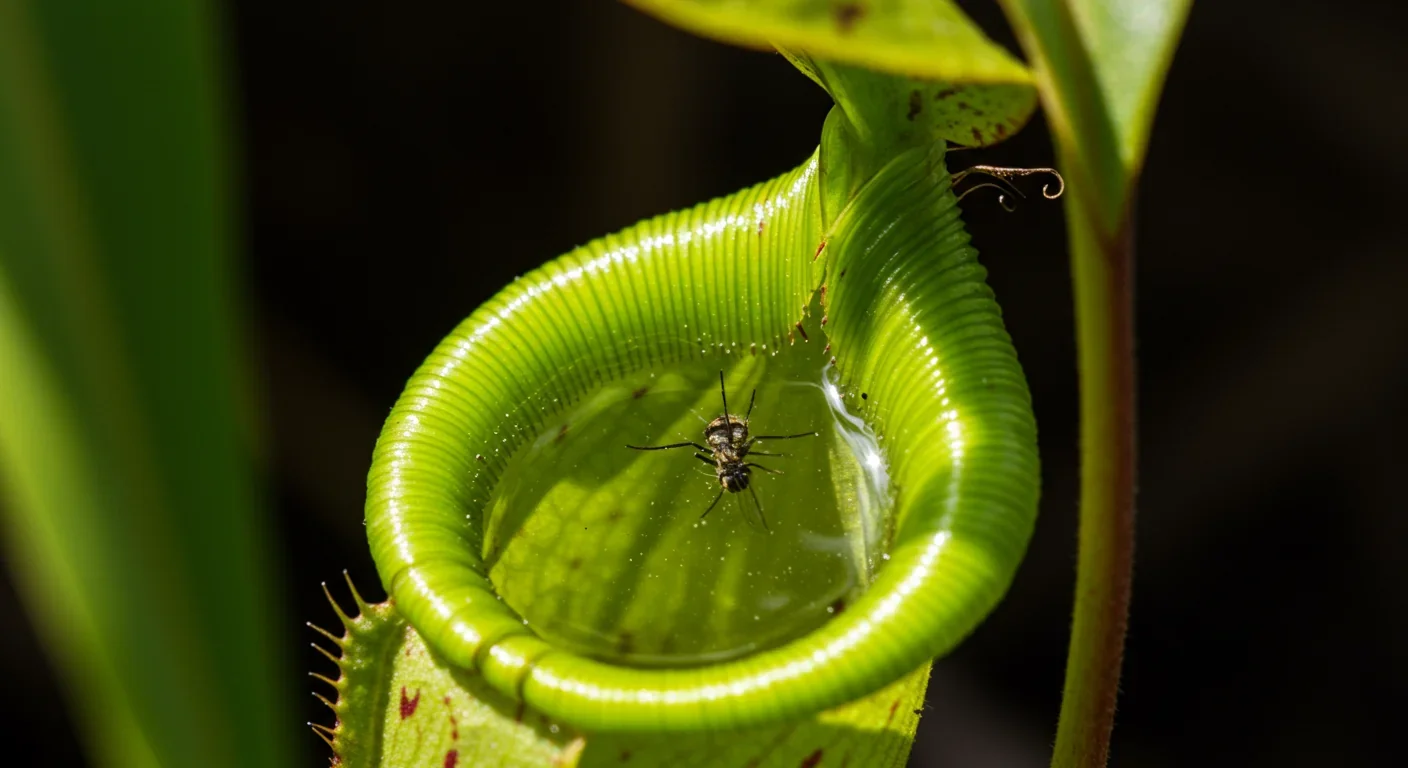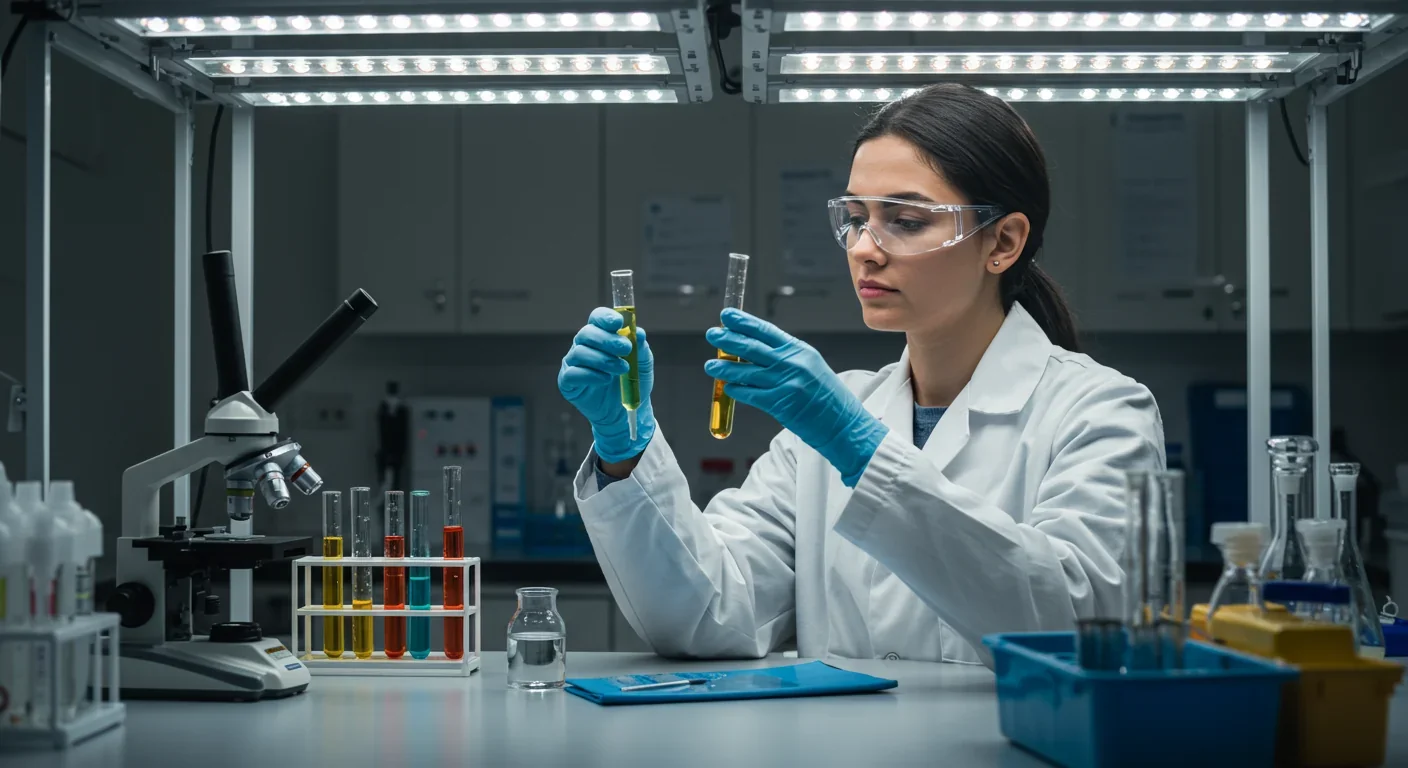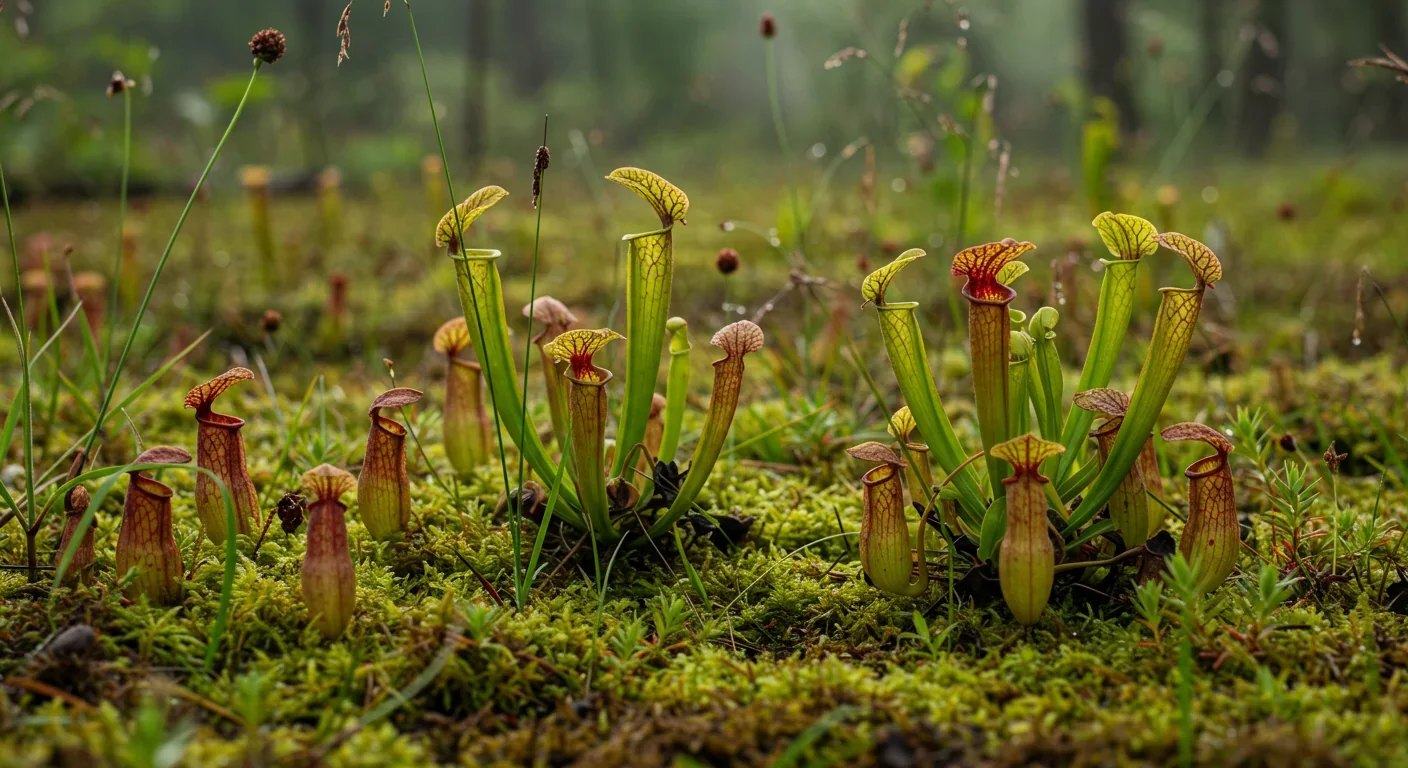Forest Biological Clocks: Ecosystems That Keep Time

TL;DR: Pitcher plants host sophisticated microbial ecosystems where bacteria and fungi digest prey in exchange for habitat, revealing functional redundancy across species and inspiring future biotechnology applications in bioremediation, agriculture, and medicine.

What if the future of waste management, antibiotic discovery, and even sustainable agriculture is hiding inside the leaves of a carnivorous plant? Scientists studying pitcher plants have uncovered something remarkable: these botanical traps aren't just passive death chambers. They're bustling microbial cities where bacteria and fungi work alongside the plant in a partnership millions of years in the making. As we grapple with antibiotic resistance and search for nature-inspired solutions to pollution, these thumbnail-sized ecosystems might hold answers we desperately need.
Inside each pitcher hangs a pool of fluid that looks deceptively simple. But recent research reveals it's actually a sophisticated biotech factory. When an insect tumbles into a Sarracenia pitcher, it doesn't just drown. It enters an assembly line where thousands of microbial workers dismantle it molecule by molecule.
The pitcher starts sterile, containing antimicrobial proteins—proteases, chitinases, pathogenesis-related compounds—that keep out unwanted colonizers before the trap opens. Once exposed to air, select bacteria and fungi move in. Not random hitchhikers, but specialized teams the plant essentially recruits.
Scientists sequencing these communities found something stunning: across different pitcher plant species and even hybrid offspring, the microbial lineup changes dramatically, yet the functions they perform stay remarkably consistent. Think of it like different kitchen crews using different tools but all producing the same meal. This functional redundancy suggests evolution locked in certain metabolic jobs as non-negotiable, no matter which microbes fill the roles.
Serratia bacteria, for instance, secrete a toolkit of enzymes—DNase to shred DNA, proteases to cleave proteins, chitinases to crack open insect exoskeletons. Serratia species are ecological generalists found in soil, water, and on plants, but inside pitchers they become precision demolition experts. They even produce a red pigment called prodigiosin, turning some pitcher fluids faintly pink, a visible marker of their metabolic activity.
Fungi contribute too, producing enzymes plant genes alone couldn't manufacture. Together, this microbial consortium breaks down prey into amino acids, nitrogen compounds, and phosphorus that the plant absorbs through specialized cells lining the pitcher wall.
Carnivorous plants didn't invent predation from scratch. They evolved it slowly, in nutrient-starved bogs and swamps where nitrogen and phosphorus were scarce. Pitcher plants turned leaves into traps, but they lacked one thing: the enzymatic firepower to fully digest tough insect bodies on their own.
Enter the microbes. Some pitcher species, like Heliamphora, produce almost no digestive enzymes themselves. They rely almost entirely on bacteria to do the work. Only one known species, Heliamphora tatei, bothered evolving its own enzymes, and even then it likely benefits from microbial backup.
This division of labor mirrors partnerships we see across nature: corals and their photosynthetic algae, termites and their cellulose-digesting gut microbes, humans and our sprawling intestinal flora. But pitcher plants take it further. They've essentially outsourced a core survival function to an entire community.
Research using a Sarracenia mapping population—hybrids of S. purpurea and S. psittacina—showed that host genetics strongly influence which microbes colonize the pitcher, yet the community's functional output remains stable. The plant doesn't care if it's Serratia marcescens or another species doing the digesting, as long as someone's breaking down chitin and releasing nitrogen.
This suggests something profound: the plant has evolved mechanisms to curate its microbial partners, selecting for function over identity. It's less like hiring specific individuals and more like posting a job description evolution wrote millions of years ago.
Until recently, studying these microbiomes meant culturing bacteria in petri dishes—a method that captures maybe 1% of microbial diversity, since most species refuse to grow in labs. Modern genomics changed everything.
Researchers now extract DNA directly from pitcher fluid, sequence millions of genetic fragments, and reconstruct the community's composition and activity. One landmark study sequenced over 8.9 million full-length bacterial gene reads from Sarracenia pitchers, achieving 93% taxonomic classification. They identified distinct community clusters, with certain "hub" and "connector" genera orchestrating interactions across the ecosystem.
But DNA alone only tells you who's present. To understand what they're doing, scientists use metatranscriptomics—sequencing active RNA transcripts to see which genes microbes are actually expressing in real time. This revealed over 50,000 microbial genes linked to plant growth-promoting functions: biofertilization, bioremediation, stress regulation, immune signaling.
In other words, these microbes aren't just digesting prey. They're producing compounds that help the plant tolerate harsh environments, fend off pathogens, and regulate growth. The pitcher becomes not just a stomach but a symbiotic organ where plant and microbe metabolisms intertwine.
Researchers have also discovered that different pitcher ages host different communities. Young pitchers, freshly opened, harbor pioneering species. Older pitchers, full of decaying matter, support decomposer specialists. The ecosystem matures like a forest, cycling through successional stages.
And there's drama. Mosquito larvae live in some pitchers, grazing on bacteria and filtering organic debris. They're part of the nutrient cycle, accelerating breakdown and making nitrogen available to the plant faster. Yet if larvae populations explode, they can disrupt the microbial balance, reducing digestion efficiency. The plant tolerates them, but only to a point.

If you think microbial ecosystems in carnivorous plants are niche curiosities, think again. The biotechnology industry is already eyeing them.
Researchers like Michelle Bittleston are exploring how pitcher microbiomes could inspire bioremediation—using microbes to clean up pollutants. If bacteria inside pitchers can dismantle complex organic matter in acidic, low-nutrient conditions, could engineered strains tackle plastic waste or industrial runoff?
Then there's the enzyme treasure trove. Chitinases—enzymes that break down chitin, the tough polymer in insect shells—are valuable in agriculture for controlling fungal pests (fungi also have chitin in their cell walls). Pitcher plant microbes produce highly efficient chitinases adapted to work in harsh conditions. Isolating and commercializing these enzymes could reduce reliance on chemical pesticides.
Pharmaceutical companies are interested too. The antimicrobial proteins pitcher plants produce to control which microbes colonize their traps could inspire new antibiotics. As resistance to existing drugs spreads, we desperately need fresh molecular scaffolds. Nature's been running chemistry experiments for eons; we're just starting to read the results.
There's also potential in understanding microbial community assembly. How does a plant recruit the right partners from a chaotic external environment? If we crack that code, we might engineer crop microbiomes to boost yields without fertilizers, or design probiotics that reliably colonize human guts to treat disease.
Some scientists speculate we'll see "designer microbiomes" within a decade—customized microbial communities tailored to specific industrial or agricultural tasks, inspired by how pitcher plants curate theirs. Already, companies are marketing bacterial inoculants for crops, but success rates are inconsistent. Pitcher plants prove it's possible to maintain stable, functional microbial partnerships across varying conditions. We just need to reverse-engineer the mechanisms.
Step back and the pitcher plant microbiome starts to look like a case study in distributed labor. Plants generally can't move, can't hunt, can't flee danger. They compensate by outsourcing. They hire pollinators to carry sperm, fungi to extend root networks, and now we know, bacteria to digest prey.
This raises a question with implications far beyond botany: When does outsourcing become dependency? If most Heliamphora species lost their microbial partners, they'd starve. Their evolution doubled down on the partnership, discarding redundant digestive genes. It's efficient but risky. If environmental change disrupts microbial communities—say, through pollution or climate shifts—the plants could collapse.
Humans face a parallel dilemma. We've outsourced food production to industrial agriculture, antibiotic production to pharmaceutical giants, even cognitive tasks to AI. Efficiency brings fragility. Pitcher plants survived by maintaining functional redundancy—any microbe that does the job will do. Maybe that's a lesson: build resilience through diversity, not through betting everything on a single solution.
Indigenous peoples in tropical regions where Nepenthes pitcher plants grow have long used them practically—Nepenthes pitchers serve as natural containers for cooking rice, their fluid sometimes drunk for medicinal purposes. Western science is only now catching up to the ecological sophistication embedded in these structures.
Different cultures approach symbiotic ecology through different lenses. In Japan, researchers emphasize satoyama—the idea of humans living in balanced partnership with managed ecosystems. Japanese scientists studying pitcher plants often frame their work around sustainability and coexistence, asking how human agriculture can mimic natural symbioses.
Meanwhile, in Silicon Valley, biotech startups see pitcher microbiomes as datasets to mine. Synthetic biology firms want to edit microbial genomes, drop them into engineered plant traps, and harvest enzymes at scale. The approach is transactional: nature as a parts catalog.
European researchers, particularly in the Netherlands and UK, tend toward ecological modeling, using pitcher plants to test theories about community assembly, niche partitioning, and co-evolution. They're asking foundational questions: What rules govern who lives where? Can we predict microbiome composition from environmental variables?
In Southeast Asia, where Nepenthes species are most diverse, local scientists worry about habitat destruction. Logging and palm oil plantations are wiping out endemic pitcher species before we even catalogue their microbial residents. Every lost species is a library burned, potentially containing enzymes or symbiotic strategies we'll never recover.
International collaboration is picking up. A consortium of researchers from the US, Malaysia, and Singapore recently pooled data on hundreds of pitcher samples, building a global microbiome atlas. The goal: identify universal principles of plant-microbe partnership that transcend geography.

Within the next decade, you'll likely encounter products inspired by pitcher plant microbiomes, even if you don't realize it. Laundry detergents with enzymes modeled on microbial proteases. Agricultural sprays containing pitcher-derived bacteria that outcompete crop pathogens. Wastewater treatment plants seeded with microbial consortia optimized for rapid organic breakdown.
But the deeper transformation is conceptual. We're starting to see organisms not as individuals but as ecosystems—meta-organisms where host and microbiome are inseparable. Your body hosts trillions of bacteria that influence your mood, immune function, even behavior. You're not just you; you're a walking pitcher plant, a community in a skin-bag.
This view has ethical dimensions. If we edit human gut microbiomes to treat disease, are we practicing medicine or ecosystem management? If we engineer crop microbiomes, who owns the bacteria? Can you patent a symbiosis? Indigenous communities have cultivated plant-microbe partnerships for millennia through traditional agriculture. When corporations "discover" similar mechanisms in labs and commercialize them, is that innovation or biopiracy?
Pitcher plants won't answer these questions, but they sharpen them. They prove that nature's been engineering symbiotic ecosystems far longer than we have, with more elegance and resilience than our current industrial models manage.
If microbial partnerships are poised to reshape biotechnology, agriculture, and medicine, what skills will matter?
Interdisciplinary fluency. The researchers cracking pitcher plant microbiomes aren't just botanists or microbiologists. They're computational biologists who code, chemists who understand metabolic pathways, ecologists who think in systems. Tomorrow's innovations will come from people who can speak multiple scientific languages.
Comfort with complexity. We're used to simple cause-and-effect: drug A cures disease B. But ecosystems don't work that way. Removing one microbe might boost another's growth, cascading into unpredictable changes. Future problem-solvers will need to think probabilistically, embracing uncertainty and iteration over neat solutions.
Ethical imagination. As we gain power to redesign living systems, we'll face choices previous generations never contemplated. Should we release engineered microbes into wild ecosystems? How do we weigh short-term gains against long-term risks? Pitcher plants teach humility—evolution spent millions of years fine-tuning these partnerships. We're tinkering with tools we barely understand.
Biomimicry as a mindset. Instead of asking "How do we build this?" increasingly we'll ask "How did nature already solve this?" The pitcher plant's solution to nutrient scarcity—recruit microscopic partners—beats brute-force genetic engineering in elegance. Looking to evolved systems for inspiration isn't just clever; it's survival strategy.
Peering into a pitcher plant, you're looking at a world complete unto itself: predator, prey, decomposers, symbionts, all cycling matter and energy in a space smaller than a shot glass. It's easy to see it as alien, divorced from our lives.
But zoom out and the parallels emerge. Cities are pitcher plants—trapping resources, importing energy, hosting vast microbial (and human) communities that break down waste and build complexity. Your gut is a pitcher plant, maintaining a curated microbial ecosystem that extracts nutrients from food you couldn't digest alone.
The lesson isn't just that microbes matter. It's that relationships matter. Pitcher plants thrive not because they're strong individually but because they've mastered collaboration. They've evolved systems to attract the right partners, exclude the wrong ones, and maintain functional stability even as participants change.
As we face global challenges—climate change, resource depletion, disease—our success may hinge less on individual brilliance than on our ability to orchestrate partnerships: between disciplines, between nations, between humans and the microbial world we've ignored for too long.
The tiny jungle inside the pitcher plant isn't just a biological curiosity. It's a preview of how we might live if we learn to think like ecosystems instead of individuals. And that shift, quiet as microbial digestion, might be the most revolutionary change of all.

MOND proposes gravity changes at low accelerations, explaining galaxy rotation without dark matter. While it predicts thousands of galaxies correctly, it struggles with clusters and cosmology, keeping the dark matter debate alive.

Ultrafine pollution particles smaller than 100 nanometers can bypass the blood-brain barrier through the olfactory nerve and bloodstream, depositing in brain tissue where they trigger neuroinflammation linked to dementia and neurological disorders, yet remain completely unregulated by current air quality standards.

CAES stores excess renewable energy by compressing air in underground caverns, then releases it through turbines during peak demand. New advanced adiabatic systems achieve 70%+ efficiency, making this decades-old technology suddenly competitive for long-duration grid storage.

Our brains are hardwired to see patterns in randomness, causing the gambler's fallacy—the mistaken belief that past random events influence future probabilities. This cognitive bias costs people millions in casinos, investments, and daily decisions.

Forests operate as synchronized living systems with molecular clocks that coordinate metabolism from individual cells to entire ecosystems, creating rhythmic patterns that affect global carbon cycles and climate feedback loops.

Generation Z is the first cohort to come of age amid a polycrisis - interconnected global failures spanning climate, economy, democracy, and health. This cascading reality is fundamentally reshaping how young people think, plan their lives, and organize for change.

Zero-trust security eliminates implicit network trust by requiring continuous verification of every access request. Organizations are rapidly adopting this architecture to address cloud computing, remote work, and sophisticated threats that rendered perimeter defenses obsolete.